AMALFI PENINSULA - 2007
 Friday, April 10, 2015 at 08:25PM
Friday, April 10, 2015 at 08:25PM To walk on the Amalfi coast is to experience some of the world's most sublime scenery without the attendant risk of death on the Amalfi coast highway. Italian drivers have long since lost their fear of blind corners and drops of hundreds of feet into the Mediterranean, and from all appearances they are always late getting to wherever they need to be – hence their hurry. From Naples, we made our way to Amalfi, the starting point of the walk, across the backbone of the peninsula, scrupulously avoiding the coastal road and its kamikaze drivers.
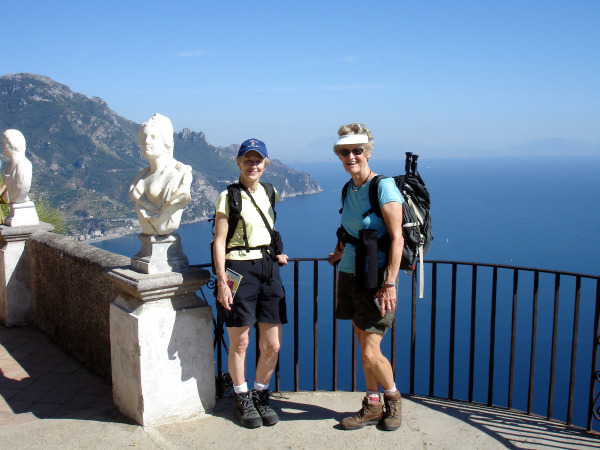 Ellie and Suzy at Villa Cimbrone
Ellie and Suzy at Villa Cimbrone
We had arrived a day before the hike was to begin, and that was just long enough; spectacular as Amalfi's location is, one day was all we needed to be glad to leave it and the swarming tourists behind. After breakfast and a brief stop to buy calzone for our lunch, we and our small group headed up the Valle dei Mulini, named for the paper mills that operated there from as early as the 12th century until catastrophic flooding closed the last of them in 1954. Now only ruins and a small museum remain.
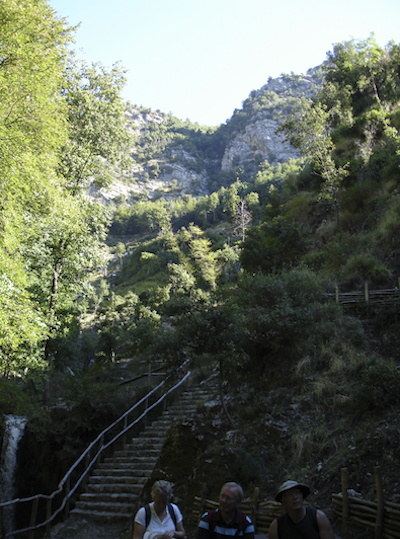 Valle dei Mulini
Valle dei Mulini
It was a steep uphill walk, and we were not far into it before it became apparent that one pair in the group would not be with us for the duration. The cigarettes they puffed on as we walked and the emergency bottle of wine poking out of a back pocket were dead giveaways. Luckily one of them spoke Italian, and while they soon abandoned hiking in favor of local transportation, they would meet up with us each evening - having carefully scoped out the good restaurants in whichever town we were.
We abstemious ones soldiered on to the village of Pontone, and from there to Ravello – surely one of the most stunning spots on the globe. The town was founded in the 5th century, and prospered mightily from its wool industry. The wealth resulted in a number of splendid palazzi, including the Villa Rufolo and the Villa Cimbrone.
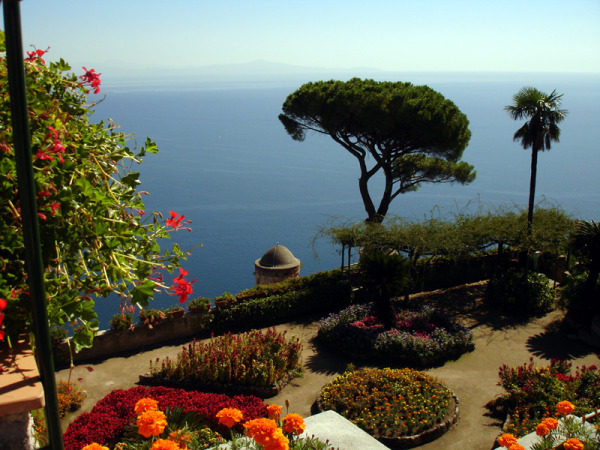 View from terrace of Villa Rufolo
View from terrace of Villa Rufolo
No longer the commercial power it once was, Ravello now hosts the world famous Ravello Festival. Sometimes dubbed the “Wagner Festival” because of Richard Wagner's visit to and enchantment by Ravello, this annual summer event has grown into a two-month-long celebration of much more than the music of Wagner himself, and now includes chamber groups, jazz ensembles, art and photographic shows, dance and discussion groups.
The next day began with the purchase of sandwiches for lunch, and there we came face-to-face with the crafty mercantile obduracy that had done so well for Ravello. The shopkeeper who made the mortadella sandwiches for us refused to add any mayonnaise to them unless we purchased an entire jar of it – of which we had no need and for which we had no refrigeration. Beaten in that skirmish, we hopped on a public bus for the short ride to Scala, the oldest town on the Amalfi coast. And from there it was an almost endless ascent of steps before the terrain leveled off for a gorgeous walk along one side of a small river in the Valle delle Ferriere, or “valley of the ironworks.”
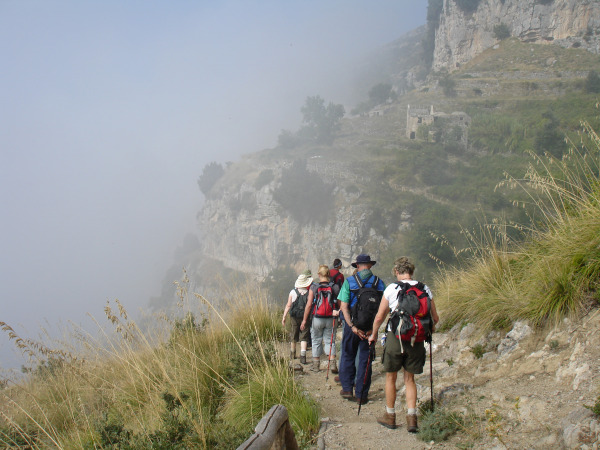 On the trail near the Valle dell FerriereWe were destined to begin every day with many steps. We had been warned. With sheer, breathtaking drops you get steps. If you want flat you should go to Holland. At last a steep descent brought us down into the “fjord” of Furore where we ate lunch perched on some boats moored in the inlet. There is no getting around the fact that the flip side of a steep descent is a steep ascent, and that is what awaited us after lunch. We ended that day in Praiano, on the coast midway between Amalfi and Positano, our eventual destination.
On the trail near the Valle dell FerriereWe were destined to begin every day with many steps. We had been warned. With sheer, breathtaking drops you get steps. If you want flat you should go to Holland. At last a steep descent brought us down into the “fjord” of Furore where we ate lunch perched on some boats moored in the inlet. There is no getting around the fact that the flip side of a steep descent is a steep ascent, and that is what awaited us after lunch. We ended that day in Praiano, on the coast midway between Amalfi and Positano, our eventual destination.
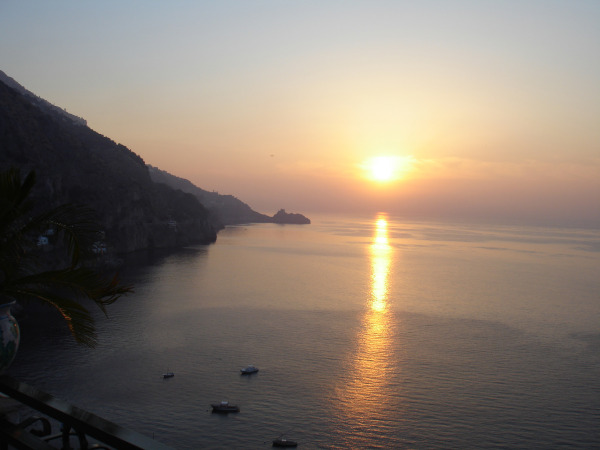 Sunset in Praiano
Sunset in Praiano
It was in Praiano the next night that the group celebrated one of Ellie's ever-growing number of birthdays. The restaurant was beautifully situated at water's edge, and the limoncello flowed freely. Have we mentioned that this part of Italy is literally steeped in limoncello? It is a delicious aperitif, and not surprisingly it shows up as gelati, sorbets, and confections of all description. But not content to let the appeal end there, the lemon theme has branched out into soaps, showers gels, hand lotion and candles. And doubtless plenty of other products; entire shops do a roaring business offering nothing that isn't lemon flavored.
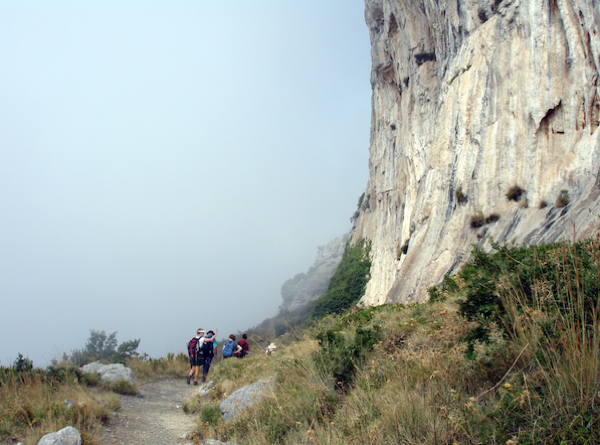 Cliffs on the Sentierio Degli DeiThe prior night's restaurant was at sea level, and our destination the next day, the monastery of San Comenico, was 1,935 feet above sea level, with nothing separating the two except for 946 steep stone steps. For the sake of comparison, the Empire State Building is 1,250 feet, the Eiffel Tower a mere 986 feet. Most people choose elevators to get to the top of those; we didn't have that option. Brutal heat added to the enjoyment. If the reason for situating the monastery there was to discourage the young monks from slipping out for a night on the town below, it surely worked. Going down into Positano, after lunch, was definitely easier.
Cliffs on the Sentierio Degli DeiThe prior night's restaurant was at sea level, and our destination the next day, the monastery of San Comenico, was 1,935 feet above sea level, with nothing separating the two except for 946 steep stone steps. For the sake of comparison, the Empire State Building is 1,250 feet, the Eiffel Tower a mere 986 feet. Most people choose elevators to get to the top of those; we didn't have that option. Brutal heat added to the enjoyment. If the reason for situating the monastery there was to discourage the young monks from slipping out for a night on the town below, it surely worked. Going down into Positano, after lunch, was definitely easier.
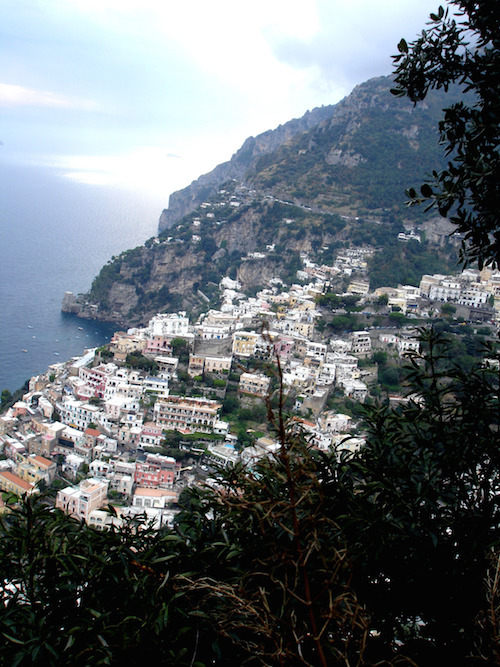 Positano from Montepertuso
Positano from Montepertuso
Positano is beautifully located, and a lot of people know that. Tourists were swarming and prices were high, but the linguine con funghi was delicious. We weren't sorry to leave it. But it was sleepy and authentic compared to Sorrento, where the hike officially ended.
One should not get that close to Pompeii, Vesuvius or Capri without visiting them, and since one of us hadn't already done so, we tacked a couple of extra days on to our trip. Short versions of each:
- Pompeii: Choose your guide carefully. This is impossible, of course, as your guide will quickly choose you the minute he spots you looking helpless. Suffice to say some guides are better than others.
- Vesuvius: You need to temporarily abandon any hopes of longevity you may harbor. The bus that takes you almost to the summit is alright, and looking down into the crater is something you'll never forget. But then there's the coming down. The road is steep, with one hairpin bend after the other, and Italian machismo will require your driver to overtake any other other vehicle on the road, no matter how blind the corner. Even the locals in our bus could be heard gasping.
- Capri: Makes you wish you were wealthy enough to live there.
In retrospect, we believe that walking in the hills above is by far the best way to experience the Amalfi coast. It has everything, tutti per i cinque sensi:
- La vista: the views of hills, towns, and the Mediterranean beyond, are better seen from above;
- L'udito: any sounds heard will be made by nature, not vehicles or radios;
- L'olfatto: the smells will be those of herbs and flowers, with an occasional whiff of limoncello;
- Il tatto: one's feet will be touching the land at every step;
- Il gusto: what is there to say? It's Italy and you cannot go wrong.
Yes, the hiking may leave you breathless at times, but breathless in a good way, in a that’s-absolutely-the-most gorgeous-view-I've-ever-seen-in-my-entire-life kind of way. Believe us, you would be just as breathless driving the Amalfi coast road, but that would be in a we-could-die-at-any-moment kind of a way.
click here to see a gallery of the photos

Reader Comments